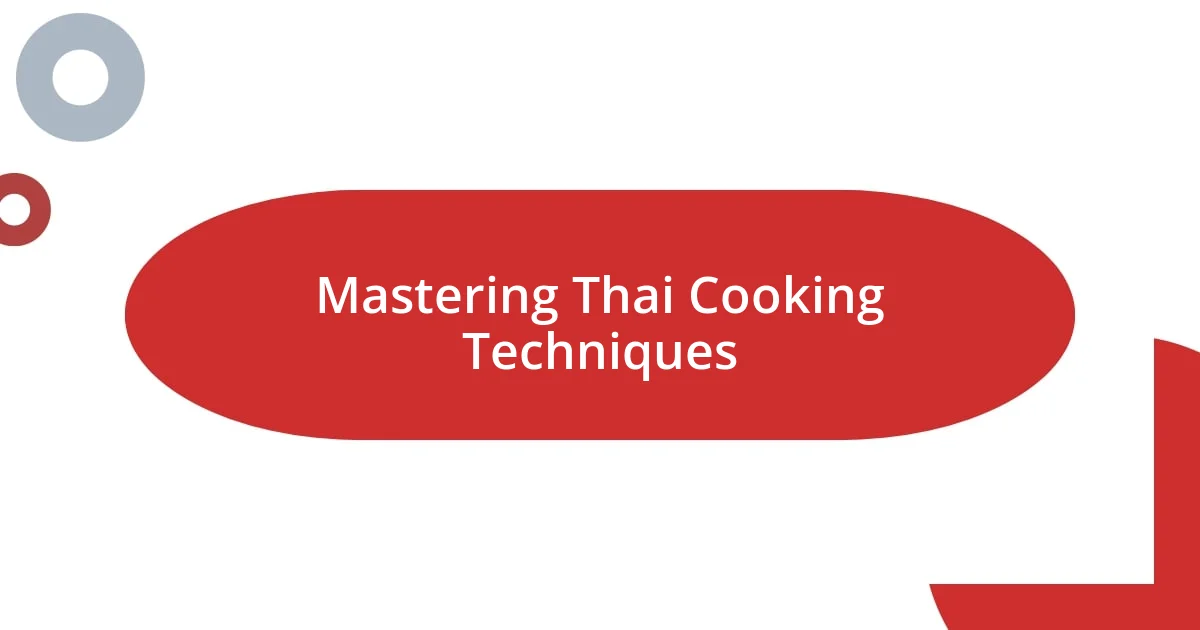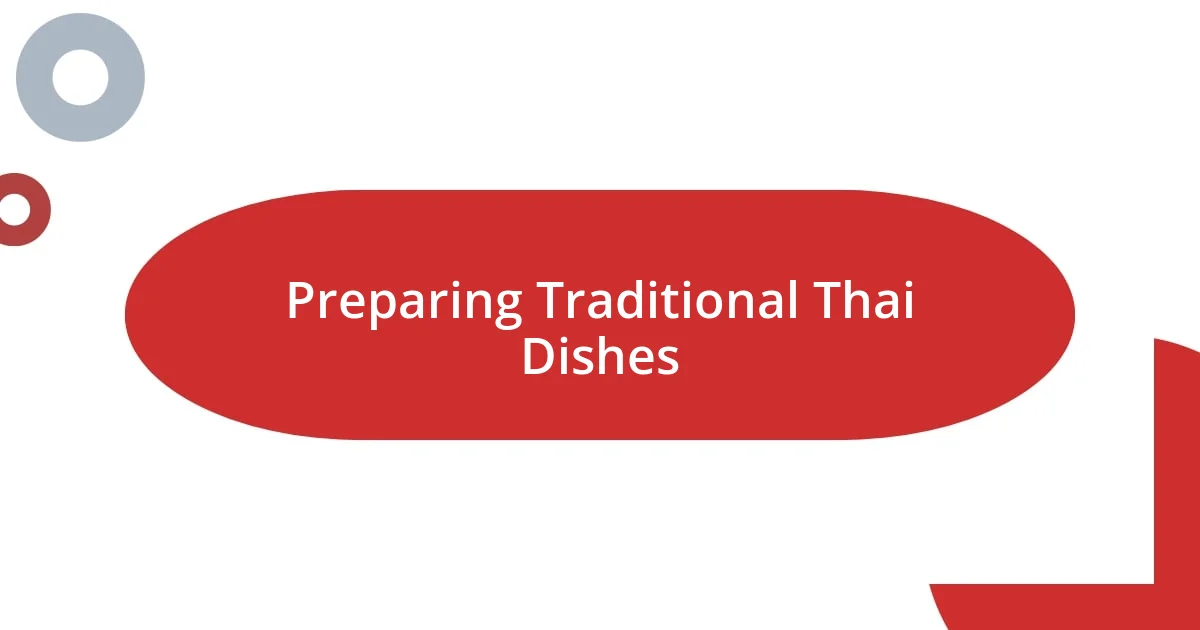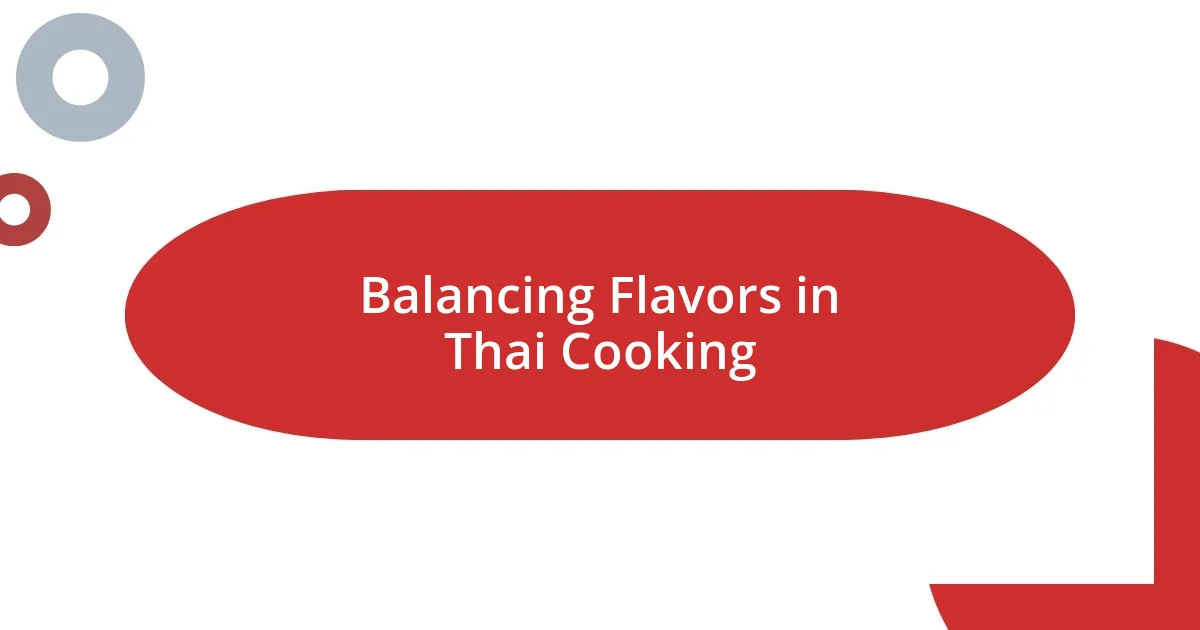Key takeaways:
- Thai cuisine balances sweet, salty, sour, and spicy flavors while emphasizing fresh herbs and spices for aroma and authenticity.
- Mastering cooking techniques like stir-frying and curry paste creation enhances both flavor and presentation, making cooking a creative process.
- Visually appealing plating and thoughtful ingredient selection elevate the dining experience, inviting deeper connections through shared meals.

Understanding Thai Cuisine Essentials
Thai cuisine is a vibrant tapestry of flavors, and at its heart lies the balance of sweet, salty, sour, and spicy elements. I still remember the first time I tasted a bowl of Tom Yum soup; the explosion of flavors felt like a dance on my palate. Isn’t it fascinating how a single dish can embody the essence of an entire culture?
An essential aspect that often surprises people is the use of fresh herbs and spices. Ingredients like lemongrass, galangal, and Thai basil elevate the dishes, making them incredibly aromatic. I once spent a day exploring a local market in Bangkok, and the scent of freshly crushed chilies and fragrant herbs was almost intoxicating. Have you ever experienced a flavor that transports you to another place?
Another cornerstone of Thai cooking is the importance of texture and presentation. Dishes often include a mix of crunchy, creamy, and chewy elements, creating a sensory experience beyond taste. I remember meticulously arranging a plate of Pad Thai, taking time to sprinkle crushed peanuts on top, not just for flavor but to enhance the visual feast. How do you think a dish’s presentation affects your appetite?

Selecting Authentic Ingredients
Selecting authentic ingredients is crucial for capturing the essence of Thai cuisine. I feel that a visit to a traditional Thai market is almost like embarking on a culinary adventure. You encounter fresh produce that not only looks vibrant but also has a story. Each herb, spice, and vegetable serves a unique purpose in the flavor profile of the dish. I remember the thrill of picking fresh kaffir lime leaves and being enveloped in their zesty aroma—it instantly transported me back to my favorite Thai restaurant.
When it comes to selecting ingredients, I always keep an eye out for:
- Fresh herbs like cilantro and mint for vibrant flavor.
- Thai chilies, which can vary in heat—don’t underestimate their spice!
- Authentic fish sauce (nam pla) for that savory depth.
- Palm sugar, a sweeter alternative to refined sugar that balances flavors beautifully.
- Thai rice varieties, such as jasmine, for their aromatic properties.
Taking the time to source the right ingredients enhances not only the authenticity of the dish but also the joy of cooking. Each ingredient is like a puzzle piece that fits into the broader picture of a beautifully complex meal. I often find myself reminiscing about flavors and memories associated with each component, which adds a deeper connection to what I’m cooking.

Mastering Thai Cooking Techniques
Mastering Thai cooking techniques requires a blend of practice and an understanding of how each method influences flavor and texture. One technique that I cherish is stir-frying, which involves cooking over high heat for a short period. I once experimented with this method making a simple vegetable stir-fry. The vibrant colors and crisp textures achieved through quick cooking made the dish not just delicious but a feast for the eyes, emphasizing the idea that cooking is as much about aesthetics as it is about taste.
Another fundamental technique worth exploring is the art of creating curry pastes. I remember the first time I ground spices into a curry paste using a mortar and pestle. It felt like a rite of passage—transforming simple ingredients into something fragrant and powerful. Unlike store-bought pastes, homemade versions retain a freshness that elevates any dish they touch, making each meal feel like a true labor of love.
Lastly, proper balancing of flavors is crucial in Thai cooking. I always say that cooking is about making adjustments based on taste, and Thai cuisine embodies this. I recall a moment when I was preparing a batch of green curry and needed a touch more sweetness. A spoonful of palm sugar turned the dish from good to extraordinary. Isn’t it amazing how a simple tweak can completely change the experience of a dish?
| Technique | Description |
|---|---|
| Stir-Frying | Quick cooking over high heat to preserve flavor and texture. |
| Curry Paste Creation | Grinding spices and fresh ingredients for a homemade, aromatic base. |
| Balancing Flavors | Adjusting ingredients like sugar, salt, and acid to achieve harmony. |

Preparing Traditional Thai Dishes
When it comes to preparing traditional Thai dishes, I find that organization is key to an enjoyable cooking experience. I remember setting up my workspace like a mise en place, where every ingredient is neatly arranged and ready to go. This not only keeps me focused but also builds excitement as I transition from one step to another. Have you ever noticed how a little prep can transform a chaotic kitchen into a calm cooking haven? It’s a game changer for maintaining that flow, especially when the stove is sizzling with a fragrant curry and the aroma is intoxicating.
One of my favorite moments is when I simmer a pot of tom yum soup. The bubbling broth, infused with lemongrass, galangal, and kaffir lime leaves, fills the air with a medley of tantalizing scents. I can almost hear the soup singing as it develops complex flavors, and I can’t resist tasting along the way. This dish has a way of connecting me with shared meals and laughter from family gatherings. Do you ever find yourself lost in a flavor that reminds you of a special time? For me, that’s the magic of preparing traditional Thai dishes—it evokes memories that linger long past the last bite.
Finally, plating is an art that I cherish as much as cooking itself. I recall experimenting with different arrangements for a vibrant pad thai, letting my creative juices flow as I sprinkled crushed peanuts and a squeeze of lime on top. The satisfaction of stepping back and admiring my final creation before sharing it with loved ones is unparalleled. I always ask myself: how does this presentation enhance the eating experience? It’s incredible how a thoughtfully plated dish can elevate a simple meal into an unforgettable feast.

Balancing Flavors in Thai Cooking
Finding the right balance of flavors in Thai cooking is a journey I deeply enjoy. Each dish is a delightful dance between sweet, sour, salty, and spicy—like a symphony of taste that leaves your palate singing. I remember one night, experimenting with a som tam (green papaya salad), I struggled between adding more lime juice or brown sugar. I ultimately chose a hint of extra sugar, transforming the dish into a perfect harmony of sweet and tangy. Have you ever had that moment when adjusting a flavor unlocked a whole new world in your dish? For me, it’s these little decisions that truly make cooking so rewarding.
The beauty of balancing flavors often lies in understanding the ingredients’ roles. Fresh herbs, like cilantro or mint, can cut through heavy fats, while chilies provide that needed kick. When I was creating a coconut soup, I had an epiphany. I thought adding just a bit of fish sauce would deepen the flavor, but I was hesitant. After taking the plunge and incorporating it, the soup was elevated from merely comforting to utterly divine. Do you see how each ingredient contributes uniquely? This delicate interplay is what brings Thai dishes to life.
Lastly, it’s all about intuition and experience. Every time I cook, I remind myself to trust my taste buds. I can’t tell you how many times I’ve tasted a dish and instinctively known it needed a touch more acidity or sweetness. Recently, while making pad kra pao (basil stir-fry), I felt an intense craving for heat. I decided to add a few more sliced bird’s eye chilies, and it was as if fireworks exploded on my taste buds! Have you ever instinctively known what a dish needs? This sense of balance can only come from continuous practice and a love for cooking; it transforms each meal into a passionate expression of flavor.

Presenting Thai Food Beautifully
When it comes to presenting Thai food, I believe that aesthetics play as crucial a role as flavor. I remember one time when I prepared a colorful green curry, and rather than just plopping it in a bowl, I decided to layer it over a bed of jasmine rice. The way the vibrant greens contrasted with the white rice created an inviting tableau that made my family’s mouths water even before the first bite. Have you noticed how the sight of food can spark excitement? It’s a simple yet transformative technique that underscores the connection between the visual and culinary experience.
I often incorporate fresh herbs and flowers for a pop of color and texture. One memorable dinner featured a platter of spring rolls, and I artfully arranged them on a banana leaf with an array of dipping sauces in small bowls. To elevate the presentation even further, I garnished the dish with bright cilantro leaves and edible flowers. The eye-catching display didn’t just make the meal gorgeous; it also invited everyone to enjoy the feast together. Isn’t it fascinating how a little thoughtfulness in presentation can bring people to the table with eager anticipation?
Furthermore, I’ve come to appreciate the power of balance in my presentations. Recently, while hosting a small gathering, I made sure to complement a rich massaman curry with light, refreshing sides like a cucumber salad and mango slices. As I arranged everything on the table, I thought about how each dish contributed not just to the meal but to the overall experience. There’s something heartwarming about sharing a meal that’s both visually appealing and harmonious in flavor. How do you envision your own meals coming together? For me, the joy of creating a beautiful spread is just as fulfilling as savoring each delicious moment.















